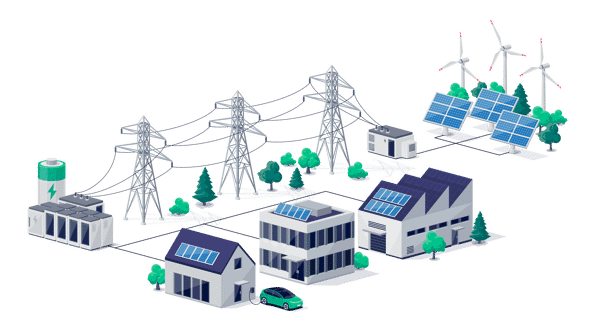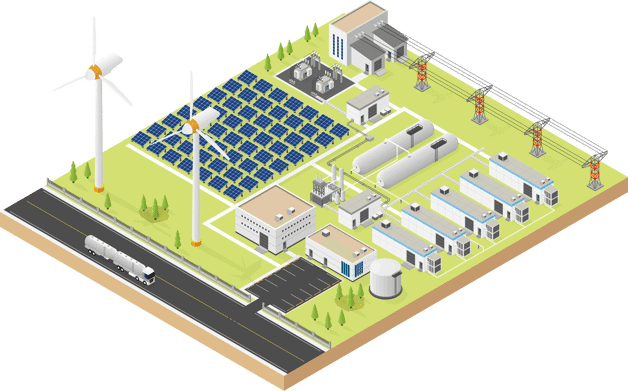The Inflation Reduction Act seems to check most of the boxes necessary for making the U.S. electrical grid run on 100% clean electricity by 2035 and a zero-emissions economy by 2050 possible. There are incentives for solar, battery storage, wind, electric vehicles, and more! While this will undoubtedly bring more renewables to the grid, we’d be remiss not to point out that our current electrical grid infrastructure needs a lot of work to handle this influx of renewables. The good news is that the Department of Energy and our federal administration sees the work that needs to be done to prepare for a clean energy transition. There are incentives supporting grid upgrades and investments being made in the technology needed for a more resilient grid as well as the allowance for distributed generation. In this blog, we cover a number of initiatives underway to invest in the grid of the future.
As it stands, our grid is designed so that power is generated in large power plants and then fed into high voltage transmission lines through which it travels over long distances. Along the way, it gets filtered into local distribution areas to end users. The power only ever goes one way and according to the Energy Information Administration, about 5% of energy is lost nationwide annually. This costs the U.S. economy up to $70 billion every year.
As more renewables are added to our energy mix, excess energy is returned to the grid, going against its top-down model. Oftentimes, circuit breakers and transformers will even try to stop the flow of electricity back to the grid. To improve the reliability of our nation’s grid while undergoing a transition to clean energy, energy storage, transmission expansion, and flexibility will be key. We will also need the infrastructure for a future that relies largely on distributed generation. The U.S. Solar Energy Technologies Office is funding research and development that can modernize current grid infrastructure to integrate solar, wind, and energy storage. This research includes studying distributed generation and resilient distribution systems that support solar energy. The Resilient Distribution Systems Lab is developing smart approaches to strengthen the resilience of electricity distribution systems including microgrids transmitting power sourced from clean distributed energy resources.
Distributed Generation
Distributed generation refers to a variety of technologies that generate electricity at or near where it will be used. Think of solar with battery storage. Distributed resources come in the form of rooftop solar, community solar, wind, and energy storage. With distributed generation, electricity is distributed near the point of use rather than from far-away power plants as our current grid transmits power.

Investing in grid upgrades that embrace distributed energy will lead to more resiliency and reliability in electricity generation. This is why distributed energy resources must be part of the conversation as we discuss ramping up our renewable energy mix and adding more utility-scale energy storage.
Microgrids are key to constructing more distributed generation as they contain one or multiple types of distributed energy, and many include batteries for energy storage. They typically remain connected to the central grid but are able to run independently with islanding capability in the event of central grid outages. Solar energy, paired with energy storage, improves grid resilience by allowing small-scale systems as well as microgrids to power critical loads during grid outages. Microgrids come with a microgrid controller; the brain of the microgrid itself as it manages energy supply in a multitude of ways through increasing or decreasing the use of resources as necessary according to consumer demand. Some microgrid controllers can even monitor costs of power on the central grid as wholesale electricity costs are in constant flux based on supply and demand. Through this ability, the microgrid can pull power from the grid when it is inexpensive, and choose to deploy its own resources as costs from the grid escalate. In these functions, the microgrid makes its decisions and operates autonomously. Microgrids can provide electricity, heating, and cooling, in the form of a local energy source. Currently, there are microgrids throughout the country that power municipalities, business complexes, hospitals, and school campuses. Around the world, as microgrids become more advanced, more are being built.
Distributed generation allows the transmission of clean and reliable energy at the source. Thanks to battery storage, microgrids constructed for distributed generation can operate autonomously from the main grid whenever it goes down, as is often the case in extreme weather events.
Microgrid development receives support from the Inflation Reduction Act with up to 50% in investment tax credits for on-site clean power development.
How Distributed Generation Mitigates the Climate Crisis
Consider the difference between getting your power from renewable sources located nearby paired with a smart grid compared to centralized power from finite resources that require water for production and cooling, with power transmitted long distances through powerlines vulnerable to our rapidly changing climate. If you ask what sort of infrastructure is better for the environment as well as more sustainable, the answer is easy; distributed generation. The environmental benefits to this method of transmitting and receiving energy are numerous:
An increase in distributed generation and more microgrids will significantly reduce the pollution and greenhouse gas emissions created by powerplants
Microgrids depend on local energy sources that reduce or eliminate the wasted energy created through line loss
Distributed renewables through microgrids add resiliency during storms that disrupt the central power grid by continuing to provide power during outages
The more power we receive from renewable resources, the greater decarbonization we experience across the board

Grid Infrastructure Upgrades that Support Distributed Generation
The Biden Administration’s Bipartisan Infrastructure Law allocates $65 billion toward electric grid transmission infrastructure upgrades and construction. The Solar and Wind Grid Service’s Reliability Demonstration Program includes research intended to demonstrate that our current grid can reliably operate with renewables and distributed energy resources. That means a successful addition of more clean energy onto our grid without the risk of interruption from outages. This program is funding up to ten projects that demonstrate how utility-scale renewables paired with energy storage can support the power grid by automatically adjusting to changes in demand as well as disruptions. The Building a Better Grid Initiative includes the Smart Grid Investment Grant (SGIG) program which makes investments in smart grid technologies, tools, and techniques to increase our grid’s flexibility, functionality, and operational efficiency in order to adapt to distributed generation. The Grid Modernization Initiative by the Department of Energy states its vision:
The future grid will solve the challenges of seamlessly integrating conventional and renewable sources, storage, and central and distributed generation. It will provide a critical platform for U.S. prosperity, competitiveness, and innovation in a global clean energy economy. It will deliver resilient, reliable, flexible, secure, sustainable, and affordable electricity to consumers where they want it, when they want it, how they want it.
These particular federal programs and initiatives assure us that our nation recognizes the necessary upgrades needed to appropriately modernize our grid for a clean energy future. This clean energy future will largely be driven by solar stewards like you. More solar adoption is encouraged by the Inflation Reduction Act with the solar investment tax credit increased to 30% for solar in service between 2022 through 2033. The 30% tax credit also applies to solar paired with energy storage. The law allows battery-only projects (such as a battery retrofit) to receive the 30% federal income tax credit starting in 2023. These are just some of the incentives that Americans seeking to make the switch to clean energy can now receive. You can find more information on just what’s included in the IRA here. We recommend speaking to a trusted tax advisor for any advice regarding tax incentives you may be eligible for.
Interested in learning more about New Mexico solar programs and options? Get started with a free consultation and evaluation.

